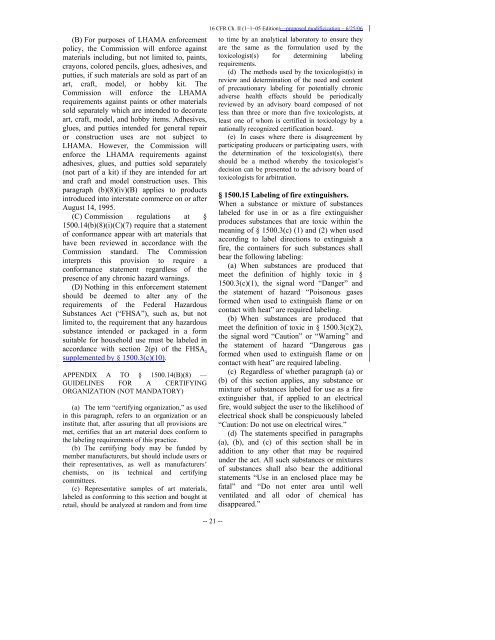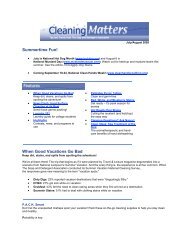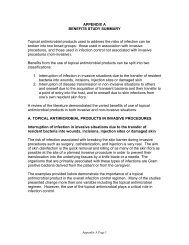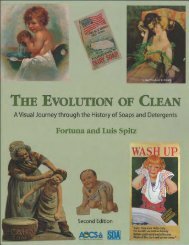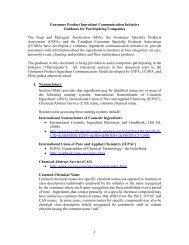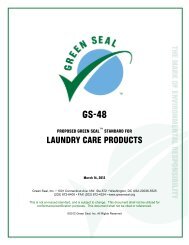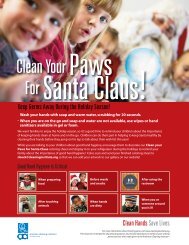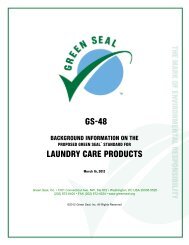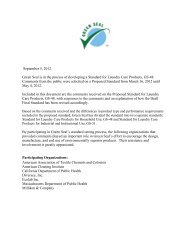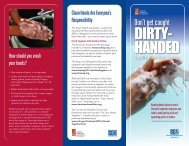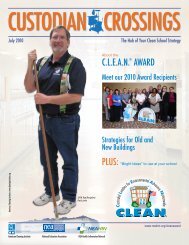subchapter c -- federal hazardous substances act regulations
subchapter c -- federal hazardous substances act regulations
subchapter c -- federal hazardous substances act regulations
You also want an ePaper? Increase the reach of your titles
YUMPU automatically turns print PDFs into web optimized ePapers that Google loves.
(B) For purposes of LHAMA enforcement<br />
policy, the Commission will enforce against<br />
materials including, but not limited to, paints,<br />
crayons, colored pencils, glues, adhesives, and<br />
putties, if such materials are sold as part of an<br />
art, craft, model, or hobby kit. The<br />
Commission will enforce the LHAMA<br />
requirements against paints or other materials<br />
sold separately which are intended to decorate<br />
art, craft, model, and hobby items. Adhesives,<br />
glues, and putties intended for general repair<br />
or construction uses are not subject to<br />
LHAMA. However, the Commission will<br />
enforce the LHAMA requirements against<br />
adhesives, glues, and putties sold separately<br />
(not part of a kit) if they are intended for art<br />
and craft and model construction uses. This<br />
paragraph (b)(8)(iv)(B) applies to products<br />
introduced into interstate commerce on or after<br />
August 14, 1995.<br />
(C) Commission <strong>regulations</strong> at §<br />
1500.14(b)(8)(i)(C)(7) require that a statement<br />
of conformance appear with art materials that<br />
have been reviewed in accordance with the<br />
Commission standard. The Commission<br />
interprets this provision to require a<br />
conformance statement regardless of the<br />
presence of any chronic hazard warnings.<br />
(D) Nothing in this enforcement statement<br />
should be deemed to alter any of the<br />
requirements of the Federal Hazardous<br />
Substances Act (“FHSA”), such as, but not<br />
limited to, the requirement that any <strong>hazardous</strong><br />
substance intended or packaged in a form<br />
suitable for household use must be labeled in<br />
accordance with section 2(p) of the FHSA,<br />
supplemented by § 1500.3(c)(10).<br />
APPENDIX A TO § 1500.14(B)(8) —<br />
GUIDELINES FOR A CERTIFYING<br />
ORGANIZATION (NOT MANDATORY)<br />
(a) The term “certifying organization,” as used<br />
in this paragraph, refers to an organization or an<br />
institute that, after assuring that all provisions are<br />
met, certifies that an art material does conform to<br />
the labeling requirements of this pr<strong>act</strong>ice.<br />
(b) The certifying body may be funded by<br />
member manuf<strong>act</strong>urers, but should include users or<br />
their representatives, as well as manuf<strong>act</strong>urers’<br />
chemists, on its technical and certifying<br />
committees.<br />
(c) Representative samples of art materials,<br />
labeled as conforming to this section and bought at<br />
retail, should be analyzed at random and from time<br />
16 CFR Ch. II (1–1–05 Edition)—proposed modificication – 6/25/06<br />
-- 21 --<br />
to time by an analytical laboratory to ensure they<br />
are the same as the formulation used by the<br />
toxicologist(s) for determining labeling<br />
requirements.<br />
(d) The methods used by the toxicologist(s) in<br />
review and determination of the need and content<br />
of precautionary labeling for potentially chronic<br />
adverse health effects should be periodically<br />
reviewed by an advisory board composed of not<br />
less than three or more than five toxicologists, at<br />
least one of whom is certified in toxicology by a<br />
nationally recognized certification board.<br />
(e) In cases where there is disagreement by<br />
participating producers or participating users, with<br />
the determination of the toxicologist(s), there<br />
should be a method whereby the toxicologist’s<br />
decision can be presented to the advisory board of<br />
toxicologists for arbitration.<br />
§ 1500.15 Labeling of fire extinguishers.<br />
When a substance or mixture of <strong>substances</strong><br />
labeled for use in or as a fire extinguisher<br />
produces <strong>substances</strong> that are toxic within the<br />
meaning of § 1500.3(c) (1) and (2) when used<br />
according to label directions to extinguish a<br />
fire, the containers for such <strong>substances</strong> shall<br />
bear the following labeling:<br />
(a) When <strong>substances</strong> are produced that<br />
meet the definition of highly toxic in §<br />
1500.3(c)(1), the signal word “Danger” and<br />
the statement of hazard “Poisonous gases<br />
formed when used to extinguish flame or on<br />
cont<strong>act</strong> with heat” are required labeling.<br />
(b) When <strong>substances</strong> are produced that<br />
meet the definition of toxic in § 1500.3(c)(2),<br />
the signal word “Caution” or “Warning” and<br />
the statement of hazard “Dangerous gas<br />
formed when used to extinguish flame or on<br />
cont<strong>act</strong> with heat” are required labeling.<br />
(c) Regardless of whether paragraph (a) or<br />
(b) of this section applies, any substance or<br />
mixture of <strong>substances</strong> labeled for use as a fire<br />
extinguisher that, if applied to an electrical<br />
fire, would subject the user to the likelihood of<br />
electrical shock shall be conspicuously labeled<br />
“Caution: Do not use on electrical wires.”<br />
(d) The statements specified in paragraphs<br />
(a), (b), and (c) of this section shall be in<br />
addition to any other that may be required<br />
under the <strong>act</strong>. All such <strong>substances</strong> or mixtures<br />
of <strong>substances</strong> shall also bear the additional<br />
statements “Use in an enclosed place may be<br />
fatal” and “Do not enter area until well<br />
ventilated and all odor of chemical has<br />
disappeared.”


